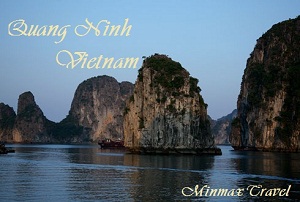- Vietnam Overview
- Main Cities in Vietnam
- Regions in Vietnam
- Other Cities in Vietnam
- Getting to Vietnam
- Getting Around Vietnam
- Language in Vietnam
- Education in Vietnam
- Vietnam Activities
- Vietnam Attractions
- Vietnam Money & Shopping
- Eating and Drinking in Vietnam
- Dress Code in Vietnam
- Gift Giving in Vietnam
- Public Behavior in Vietnam
- Art Performance
- Custom and Habits
Quang Ninh Province
 There are many beautiful beaches and natural beauty spots such as Halong Bay, Bai Tu Long Bay, Tra Co Beach, Co To Beach, Dai Beach in Van Don etc
There are many beautiful beaches and natural beauty spots such as Halong Bay, Bai Tu Long Bay, Tra Co Beach, Co To Beach, Dai Beach in Van Don etc
Geography
Quang Ninh is a mountainous and coastal province, with more than 80% of its area being made up of mountains and hills
The sea and island zone of Quang Ninh has a unique terrain. There are more than 2,000 islands, making up two thirds of the Vietnam's islands. They extend along the coast for more than 250km and divide into numerous layers. The largest islands are Cai Bau and Ban Sen, while the smallest are just like rocks in a garden. The sea bottom terrain of Quang Ninh isn't smooth, and 20m-average depth. There are the remnants of ancient streams and underwater rocky banks. The streams from the mainland connect to deep drains along the sea-floor; creating a series of waterways, canals and harbors along the coast.
Quảng Ninh is divided into two city municipalities (thành phố) (Hạ Long and Móng Cái), two municipal townships (thị xã) (Cẩm Phả, and Uông Bí), and ten rural districts (huyện): Ba Chẽ District, Bình Liêu District, Cô Tô District, Đầm Hà District, Đông Triều District, Hải Hà District, Hoành Bồ District, Tiên Yên District, Vân Đồn District and Yên Hưng District. These are divided into 130 communes (xã), 45 wards (phường) and 11 urban townships (thị)
Climates: Quang Ninh's climate is symbolic of the climate in the North Vietnam; featuring all four seasons. In summer, it's hot, humid and rainy, while monsoons flourish. In winter, it's cold, dry, and sometime rainy.
The average heat radiating during a year is 115.4 Kcal/sq. cm. The average temperature is over 21ºC, while the average humidity is 84%. Annual rainfall totals between 1,700 and 2,400mm, and there can be between 90 to 170 rainy days in a year. These are mainly concentrated in the summer (more than 85%), and especially in the months of July and August. In winter, rainfall only reaches between 150 and 400mm.
In comparison to other provinces in the north, Quang Ninh has been more under the influences of north-eastern monsoons. The wind blows strongly and the temperature drops to between 1 and 3ºC. During a north-eastern monsoon, high mountainous regions such as Binh Lieu and Hai Ha, Dam Ha sometimes see the temperature drop below 0ºC.
Storms have a large influence on the province, mainly in June, July and August. The intensity can be extremely strong, especially in island and coastal regions.
Due to differences in terrain, the climate of sub-regions vary. The border area of the Mong Cai Town is colder and rainy, with an average temperature of around 22ºC and rainfall reaching 2,751mm. In the Yen Hung District, the most southern area, the average temperature is 24ºC and sees an average rainfall of 1,700mm. The high mountainous region of Hoanh Bo, and Ba Che Districts, is victim to 20 days of frost a year, and is subject to little rainfall. In the Binh Lieu District there is heavy rain (2,400mm) and winter lasts for six months. The offshore island region is not the wettest area, with only 1,700 to 1,800mm³ of rainfall per year, but winter is often accompanied by thick mists.
Tourism
There are many beautiful beaches and natural beauty spots such as Halong Bay, Bai Tu Long Bay, Tra Co Beach, Co To Beach, Dai Beach in Van Don etc. Besides, there are historical and architectural relics enabling the development of tours on land, sea and islands.
Halong Bay covers an area of 1,553 sq. km including 1,969 islands, of which an area of over 434 sq. km including 788 islands has been recognized by UNESCO as a world heritage due to its cultural, aesthetic, bio-geological and economic value. There are in the bay many soil islands, caves, grottoes, beaches, beautiful landscapes enabling the development of attractive tourist sites of various types.
Tuan Chau Island belonging to Halong Bay has an area of 220ha. It is 8km from Halong City and 2km offshore. This is an ideal spot to develop a super tourist complex. Bai Chay Beach is a wonderful spot and provides full range of services.
With around 500 historical, cultural and arts relics, attached with many traditional festivals; such as Yen Tu Pagoda, Cua Ong Temple, Bach Dang historical relic, Long Tien Pagoda, Quan Lan Communal House etc, which attract a large number of visitors, especially during festivals.
Coming to Quang Ninh, tourists can have good chance of enjoying seafood, including holothurians, abalone, shrimp, crab, areca, shellfish, gaillardia, etc
Quang Ninh Travel Guide

